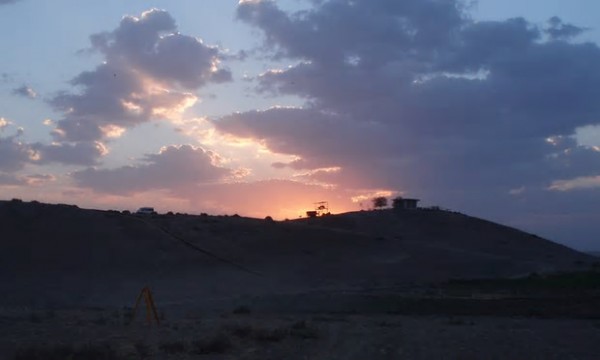
The high mound at Ziyaret Tepe as the sun comes up. This was once the citadel of the ancient Assyrian city of Tušhan . Photograph: Mary Shepperson
ishtartv.com - theguardian.com
Mary Shepperson,
Wed 7 Feb 2018
It’s
a sad fact of archaeological life that we can often only find things when
they’re about to be lost forever, but such is the unhappy marriage between
rescue archaeology and infrastructure development. Construction of the Ilisu dam, on the river
Tigris in southeast Turkey, is now complete and the flooding of 300km2 of land
behind it may begin as early as this spring. The dam will provide water
security and electricity to the local region, as well as further restrict the
diminishing flow of water downstream to Iraq, displace at least 70,000 people
and flood up to 500 archaeological sites.
Leaving
its tangled politics aside, the Ilisu dam represents a substantial loss of
cultural heritage in this archaeologically rich area, most notably the
well-publicised destruction of the beautiful and ancient town of Hasankeyf. However,
it has also provided a great opportunity to learn about the past of this
region.
When
the dam was green-lit in the early 1990s, the Turkish government invited teams
of local and international archaeologists to work in the Tigris basin upstream
of Ilisu to recover as much as possible before the dam was completed. The
result was a series of intensive survey projects, followed by more than twenty
excavations, which uncovered sites ranging from deep prehistory to the Ottoman
period. The area to be flooded is now the best-studied archaeological landscape
in eastern Turkey.
The
salvage efforts have allowed archaeologists to explore, record, and save a
tremendous archive of information. Somewhat ironically, then, the dam itself is
responsible for a great increase in our knowledge of this area.”
Prof. Tim Matney, director of the Ziyaret Tepe Project
One
of the biggest Ilisu dam salvage excavations was at the site of Ziyaret Tepe;
an imposing occupation mound rising 22 metres above the plain, within which
lies the ancient Assyrian city of Tušhan.
Tušhan
was a provincial centre which guarded the northern border of the mighty
Assyrian empire for almost 300 years (882-611 BC). It never approached the
grandeur of an Assyrian capital such as Nineveh, but it was part of the
Assyrian network of imperial control which imposed the “Yoke of Assur” over
conquered regions. Tušhan was home not just to Assyrian settlers, but to
deportees from all over the empire, uprooted from their homelands as a further
means of subjugation.
Work
at Ziyaret Tepe began in 1997 and ran for eighteen years; long enough for
students to graduate into academic careers, and for the director’s hair to turn
grey. In 2003 I arrived at the site as a fresh archaeology graduate without the
faintest idea what I was doing, not thinking for a moment I’d still be digging
there ten years later. The results of all those long sweltering summers in the
field are now finally ready to be presented, with the publication this year of
the project’s first book. It provides the most complete picture of an Assyrian
imperial town yet known.
The
governor’s palace at Tušhan, which sits on the eastern side of the high mound,
was built under king Ashurnasirpal II, who boasted about its construction in an
inscription found not far from the site. Unlike Ashurnasirpal’s magnificent
Palace at Nimrud, the throne room of which can be seen in the British Museum,
Tušhan’s provincial palace had no stone reliefs. Instead its white plastered
walls were decorated with finely painted geometric patterns in blue, red,
orange and black. The reception suite was equipped with a trackway for a
moveable heating brazier and neatly tiled bathroom facilities, giving it a
touch of luxury.
Some
of the governors themselves may have been located. Under the paving of the
palace courtyard five intact cremation burials were excavated. Whether or not
these were the governors of Tušhan, they were certainly important people,
cremated on beds with ivory fittings, and provided with bronze bowls, lamps and
ornaments. Intriguingly, cremation was not an Assyrian practice and these
burials suggest that Tušhan’s ruling elite had either adopted local customs, or
were not themselves Assyrians.
To
the south of the high mound, Tušhan had a substantial lower town and this is
where the real work of the city took place. Over many seasons the excavation
team uncovered a series of large buildings, all set around courtyards paved
with beautiful black and white chequerboard mosaics made of thousands of small,
smooth river pebbles. Most were high-status houses but one had more complex
functions. The entrance chamber to this building yielded hundreds of tiny clay
tokens; small clay objects in a range of shapes standing for different numbers
and commodities. These little pyramids, spheres, cylinders, cones, squares and
cubes are thought to have been used as accounting tools, for keeping
running-records as goods and people passed in and out.
The
administrative function of the building was confirmed when an archive of 28
cuneiform tablets was found in two rooms off the main courtyard. These include
lists of personnel, a record of resettlements and the loan of a slave, but most
concern the movement of barley. These transactions are visible throughout the
building in the form of standardised weights and huge pithoi for grain storage.
This building was a commercial and administrative hub of Assyrian Tušhan.
The
frontier character of the city, on the border with hostile Shubria, is clear
from the massive fortifications which surrounded both the high mound and the
lower town. The mudbrick city wall was two kilometres long and almost three
metres thick with a substantial ditch in front of it. The excavated southern
gateway was heavily fortified, with guard chambers on each side and troop
barracks close by.
Despite
these precautions, Tušhan fell with the rest of the Assyrian empire, conquered
by a coalition of Medes and Babylonians. The imperial capital at Nineveh fell
after a dramatic siege in 612 BC, after which the remaining Assyrian forces
retreated steadily north-westward towards the empire’s last stand at the city
of Harran. In the path of the Medes and Babylonians as they marched up the
Tigris river lay Tušhan.
It
was at this point in 611 BC that an official in the city called
Mannu-ki-libbali wrote a letter which was never sent and constitutes one of the
most extraordinary finds from Ziyaret Tepe. It details the collapse of the
empire’s logistical framework and describes the hopeless position of Tušhan in
the face of the advancing enemy.
Concerning
the horses, Assyrian and Aramean scribes, cohort commanders, officials,
coppersmiths, blacksmiths, those who clean the tools and equipment, carpenters,
bow-makers, arrow-makers, weavers, tailors and repairers, to whom should I
turn? … Not one of them is there. How can I command? … The lists are not at my
disposal. According to what can they collect them? Death will come out of it.
No one [will escape]. I am done.
Now
Tušhan faces another final enemy, as over the next couple of years the water
from the Ilisu dam advances along the same route as that used by the Medes and
Babylonians 2,600 years ago. It remains to be seen to what extent the site will
eventually be flooded, but even though its physical remains may be lost, along
with the other Ilisu sites, there is some consolation in the fact that a rich
record of the town of Tušhan, its history, people and way of life, is now
preserved in the archives and publications of the Ziyaret Tepe project.
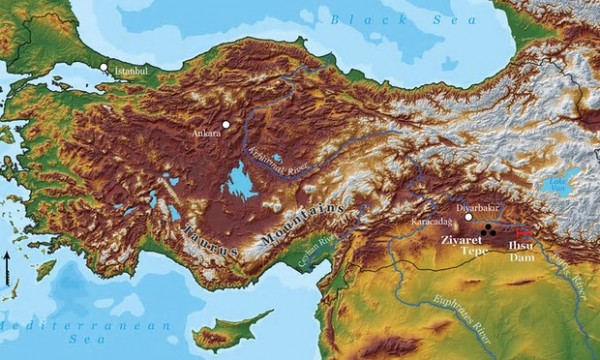
Map of Turkey showing the position of the Ilusu dam and the site of Ziyaret Tepe. Illustration: Tim Matney
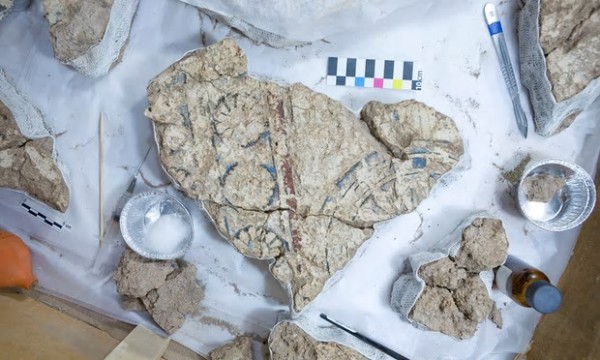
Painted wall plaster from Tušhan’s palace undergoing conservation. Photograph: Tim Matney/Courtesy of the Ziyaret Tepe Project
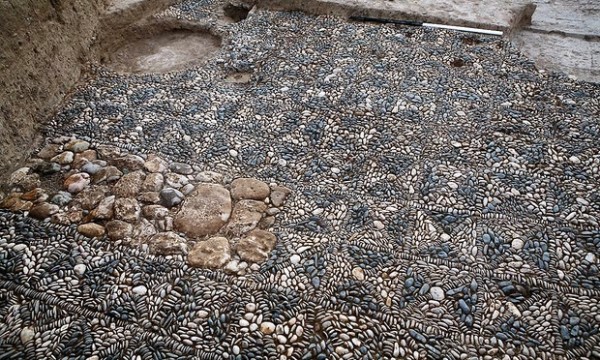
Pebble mosaic pavement in one of the courtyards of the administrative building. These chequerboard pavements are characteristic of Neo-Assyrian buildings. Photograph: Tim Matney/Courtesy of the Ziyaret Tepe Project
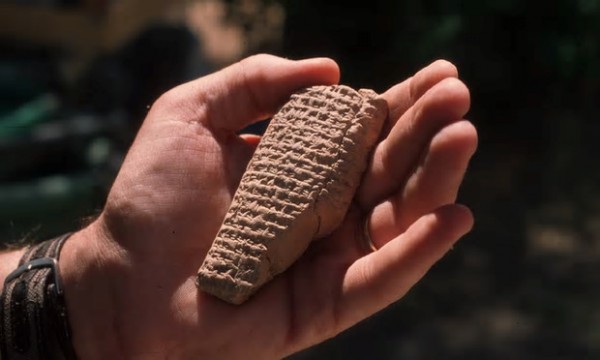
Mannu-ki-libbali’s last letter before the fall of Tušhan. Photograph: Tim Matney/Courtesy of the Ziyaret Tepe Project
|